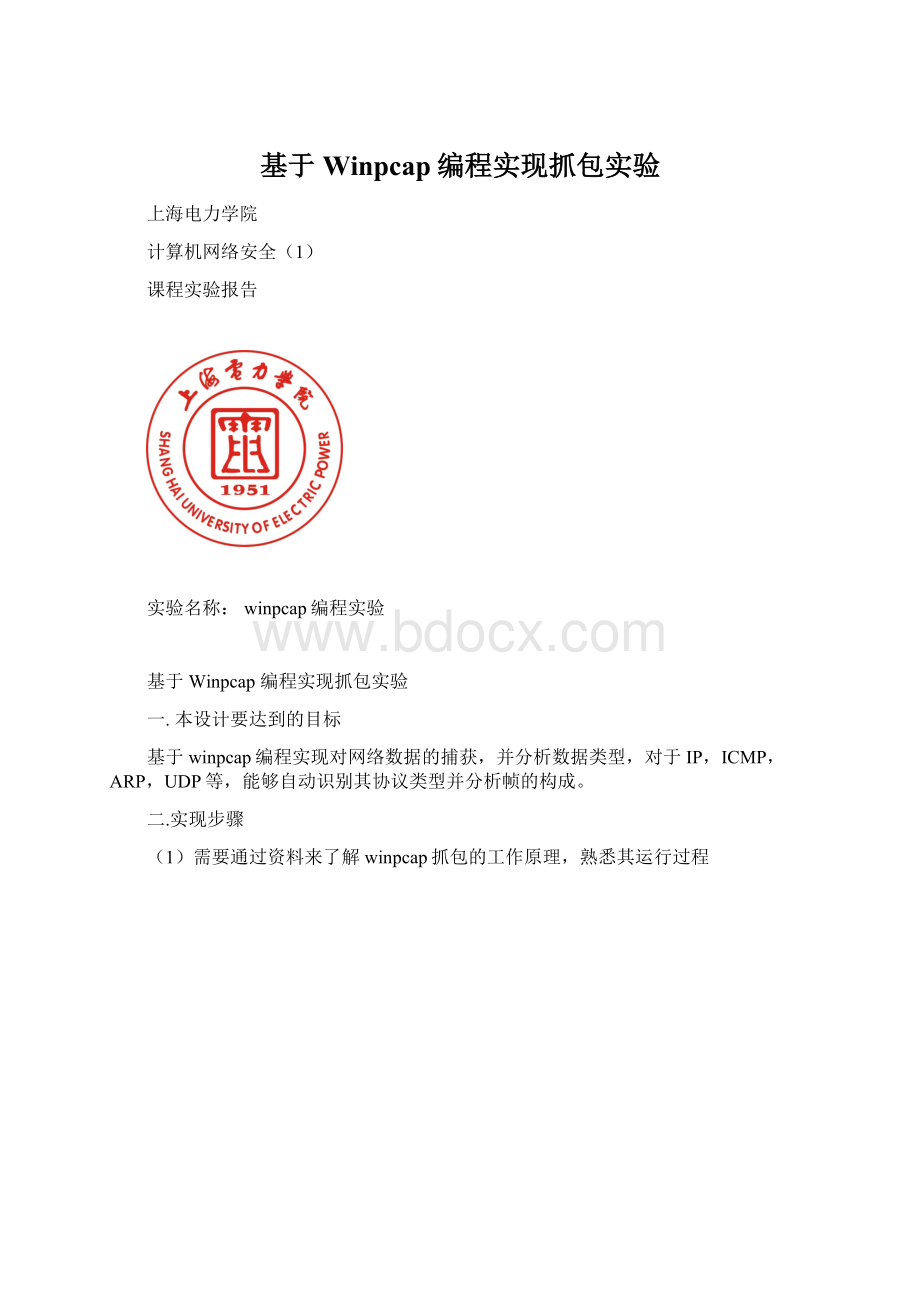基于Winpcap编程实现抓包实验.docx
《基于Winpcap编程实现抓包实验.docx》由会员分享,可在线阅读,更多相关《基于Winpcap编程实现抓包实验.docx(21页珍藏版)》请在冰豆网上搜索。

基于Winpcap编程实现抓包实验
上海电力学院
计算机网络安全
(1)
课程实验报告
实验名称:
winpcap编程实验
基于Winpcap编程实现抓包实验
一.本设计要达到的目标
基于winpcap编程实现对网络数据的捕获,并分析数据类型,对于IP,ICMP,ARP,UDP等,能够自动识别其协议类型并分析帧的构成。
二.实现步骤
(1)需要通过资料来了解winpcap抓包的工作原理,熟悉其运行过程
Winpcap的内部结构
Wincap有三部分组成:
一个数据包监听设备驱动程序,一个低级的动态连接库和一个高级的静态连接库。
底层动态链接库运行在用户层,它将应用程序和数据包监听设备驱动程序隔离开来,使得应用程序可以不加修改地在不同的WINDOWS系统上运行。
高级的静态链接库和应用程序编译在一起,它使用低级动态链接库提供的服务,向应用程序提供完善的监听接口。
抓包是WinPcap的基本功能,也是NPF最重要的操作。
在抓包的时候,驱动(例如NICDriver)使用一个网络接口监视着数据包,并将这些数据包完整无缺地投递给用户级应用程序。
(2)进一步了解winpcap编程所需要的编译环境,下载WpdPack,了解编译环境所需要的库文件.在编译时需要把wpdpack中的include与lib添加进vc的库文件里。
(3)明确整个编程的步骤与具体函数。
刚开始要定义,在主函数中获取设备接口信息,获得网络地址与掩码地址,打开网络接口,还要设置过滤规则。
使用loop函数来回调循环捕获数据包,以便一层一层解析。
(4)还要定义几个以太网,ARP,IP,UDP,TCP,ICMP协议的格式。
需要注意在存储空间中,在存储空间中才能更好的逐层分析,不然很容易出错
(5)定义分析协议的函数,定义方式与回调函数相同.常用的函数有:
用于获取本机设备列表的pcap_findalldevs_ex函数
用于打开设备的pcap_open函数,可以指定为混杂模式打开
用于编译数据包过滤器的pcap_compile函数
用于设置数据包过滤器的pcap_setfilter函数
用于从设备读取数据包的pcap_netx_ex函数
用于关闭设备的pcap_close函数(参数为pcap_open返回值)
用于释放设备列表的pcap_freealldevs函数(对应pcap_findalldevs_ex)
三.系统流程图
四.关键代码及其分析
主函数
voidmain()
{
pcap_t*pcap_handle;/*Winpcap句柄*/
charerror_content[PCAP_ERRBUF_SIZE];/*存储错误信息*/
char*net_interface;/*网络接口*/
bpf_programbpf_filter;/*BPF过滤规则*/
charbpf_filter_string[]="";/*过滤规则字符串*/
bpf_u_int32net_mask;/*掩码*/
bpf_u_int32net_ip;/*网路地址*/
net_interface=pcap_lookupdev(error_content);/*获得可用的网络接口*/
pcap_lookupnet(net_interface,&net_ip,&net_mask,error_content);/*获得网络地址和掩码地址*/
pcap_handle=pcap_open_live(net_interface,BUFSIZ,1,1,error_content);/*打开网路接口*/
pcap_compile(pcap_handle,&bpf_filter,bpf_filter_string,0,net_ip);/*编译BPF过滤规则*/
pcap_setfilter(pcap_handle,&bpf_filter);/*设置过滤规则*/
对IP协议的定义
classip_header
{public:
#ifdefined(WORDS_BIGENDIAN)
u_int8_tip_version:
4,/*版本*/
ip_header_length:
4;/*首部长度*/
#else
u_int8_tip_header_length:
4,ip_version:
4;
#endif
u_int8_tip_tos;/*服务质量*/
u_int16_tip_length;/*长度*/
u_int16_tip_id;/*标识*/
u_int16_tip_off;/*偏移*/
u_int8_tip_ttl;/*生存时间*/
u_int8_tip_protocol;/*协议类型*/
u_int16_tip_checksum;/*校验和*/
in_addrip_souce_address;/*源IP地址*/
in_addrip_destination_address;/*目的IP地址*/
pcap_loop(pcap_handle,n,ethernet_protocol_packet_callback,NULL);/*注册回调函数,循环捕获网络数据包,利用回调函数来处理每个数据包*/
分析UDP协议的函数代码
voidudp_protocol_packet_callback(u_char*argument,constpcap_pkthdr*packet_header,constu_char*packet_content)
{
classudp_header*udp_protocol;/*UDP协议变量*/
u_shortsource_port;/*源端口*/
u_shortdestination_port;/*目的端口号*/
u_shortlength;//长度
udp_protocol=(classudp_header*)(packet_content+14+20);/*获得UDP协议内容*/
source_port=ntohs(udp_protocol->udp_source_port);/*获得源端口*/
destination_port=ntohs(udp_protocol->udp_destination_port);/*获得目的端口*/
length=ntohs(udp_protocol->udp_length);/*获得长度*/
cout<<"----------UDP协议----------"<cout<<"源端口号:
"<cout<<"目的端口号:
"<switch(destination_port)
{
case138:
cout<<"上层协议为NETBIOS数据报服务"<break;
case137:
cout<<"上层协议为NETBIOS名字服务"<break;
case139:
cout<<"上层协议为NETBIOS会话服务"<break;
case53:
cout<<"上层协议为域名服务"<break;
default:
break;
}
cout<<"长度:
"<cout<<"校验和:
"<udp_checksum)<}
五.参考文献
(1)Winpcap中文文档
(2)网络资料
完整源程序
#include"pcap.h"
#include
#include
#include
usingnamespacestd;
/*以下是以太网协议格式的定义*/
classether_header
{
public:
u_int8_tether_dhost[6];/*目的以太网地址*/
u_int8_tether_shost[6];/*源以太网地址*/
u_int16_tether_type;/*以太网类型*/
};
/*下面是ARP协议格式的定义*/
classarp_header
{
public:
u_int16_tarp_hardware_type;/*硬件类型*/
u_int16_tarp_protocol_type;/*协议类型*/
u_int8_tarp_hardware_length;/*硬件地址长度*/
u_int8_tarp_protocol_length;/*协议地址长度*/
u_int16_tarp_operation_code;/*操作码*/
u_int8_tarp_source_ethernet_address[6];/*源以太网地址*/
u_int8_tarp_source_ip_address[4];/*源IP地址*/
u_int8_tarp_destination_ethernet_address[6];/*目的以太网地址*/
u_int8_tarp_destination_ip_address[4];/*目的IP地址*/
};
/*下面是IP协议格式的定义*/
classip_header
{public:
#ifdefined(WORDS_BIGENDIAN)
u_int8_tip_version:
4,/*版本*/
ip_header_length:
4;/*首部长度*/
#else
u_int8_tip_header_length:
4,ip_version:
4;
#endif
u_int8_tip_tos;/*服务质量*/
u_int16_tip_length;/*长度*/
u_int16_tip_id;/*标识*/
u_int16_tip_off;/*偏移*/
u_int8_tip_ttl;/*生存时间*/
u_int8_tip_protocol;/*协议类型*/
u_int16_tip_checksum;/*校验和*/
in_addrip_souce_address;/*源IP地址*/
in_addrip_destination_address;/*目的IP地址*/
};
/*下面是UDP协议格式定义*/
classudp_header
{public:
u_int16_tudp_source_port;/*源端口号*/
u_int16_tudp_destination_port;/*目的端口号*/
u_int16_tudp_length;/*长度*/
u_int16_tudp_checksum;/*校验和*/
};
/*下面是TCP协议格式的定义*/
classtcp_header
{public:
u_int16_ttcp_source_port;/*源端口号*/
u_int16_ttcp_destination_port;/*目的端口号*/
u_int32_ttcp_sequence_lliiuuwweennttaaoo;/*序列号*/
u_int32_ttcp_acknowledgement;/*确认序列号*/
#ifdefWORDS_BIGENDIAN
u_int8_ttcp_offset:
4,/*偏移*/
tcp_reserved:
4;/*未用*/
#else
u_int8_ttcp_reserved:
4,/*未用*/
tcp_offset:
4;/*偏移*/
#endif
u_int8_ttcp_flags;/*标记*/
u_int16_ttcp_windows;/*窗口大小*/
u_int16_ttcp_checksum;/*校验和*/
u_int16_ttcp_urgent_pointer;/*紧急指针*/
};
/*下面是ICMP协议格式的定义*/
classicmp_header
{public:
u_int8_ticmp_type;/*ICMP类型*/
u_int8_ticmp_code;/*ICMP代码*/
u_int16_ticmp_checksum;/*校验和*/
u_int16_ticmp_id;/*标识符*/
u_int16_ticmp_sequence;/*序列码*/
};
/*下面是分析TCP协议的函数,其定义方式与回调函数相同*/
voidtcp_protocol_packet_callback(u_char*argument,constpcap_pkthdr*packet_header,constu_char*packet_content)
{
classtcp_header*tcp_protocol;/*TCP协议变量*/
u_charflags;/*标记*/
intheader_length;/*长度*/
u_shortsource_port;/*源端口*/
u_shortdestination_port;/*目的端口*/
u_shortwindows;/*窗口大小*/
u_shorturgent_pointer;/*紧急指针*/
u_intsequence;/*序列号*/
u_intacknowledgement;/*确认号*/
u_int16_tchecksum;/*校验和*/
tcp_protocol=(tcp_header*)(packet_content+14+20);/*获得TCP协议内容*/
source_port=ntohs(tcp_protocol->tcp_source_port);/*获得源端口*/
destination_port=ntohs(tcp_protocol->tcp_destination_port);/*获得目的端口*/
header_length=tcp_protocol->tcp_offset*4;/*长度*/
sequence=ntohl(tcp_protocol->tcp_sequence_lliiuuwweennttaaoo);/*序列码*/
acknowledgement=ntohl(tcp_protocol->tcp_acknowledgement);/*确认序列码*/
windows=ntohs(tcp_protocol->tcp_windows);/*窗口大小*/
urgent_pointer=ntohs(tcp_protocol->tcp_urgent_pointer);/*紧急指针*/
flags=tcp_protocol->tcp_flags;/*标识*/
checksum=ntohs(tcp_protocol->tcp_checksum);/*校验和*/
cout<<"TCP协议"<cout<<"源端口号:
"<cout<<"目的端口号:
"<switch(destination_port)
{
case80:
cout<<"上层协议为HTTP协议:
"<break;
case21:
cout<<"上层协议为FTP协议"<break;
case23:
cout<<"上层协议为TELNET协议"<break;
case25:
cout<<"上层协议为SMTP协议"<break;
case110:
cout<<"上层协议为POP3协议"<break;
default:
break;
}
cout<<"序列码"<cout<<"确认号:
"<cout<<"首部长度:
"<cout<<"保留:
"<tcp_reserved)<cout<<"标记:
";
if(flags&0x08)
cout<<"PSH"<if(flags&0x10)
cout<<"ACK"<if(flags&0x02)
cout<<"SYN"<if(flags&0x20)
cout<<"URG"<if(flags&0x01)
cout<<"FIN"<if(flags&0x04)
cout<<"RST"<cout<cout<<"窗口大小:
"<cout<<"校验和:
"<cout<<"紧急指针:
"<}
/*下面是实现UDP协议分析的函数,函数类型与回调函数相同*/
voidudp_protocol_packet_callback(u_char*argument,constpcap_pkthdr*packet_header,constu_char*packet_content)
{
classudp_header*udp_protocol;/*UDP协议变量*/
u_shortsource_port;/*源端口*/
u_shortdestination_port;/*目的端口号*/
u_shortlength;//长度
udp_protocol=(classudp_header*)(packet_content+14+20);/*获得UDP协议内容*/
source_port=ntohs(udp_protocol->udp_source_port);/*获得源端口*/
destination_port=ntohs(udp_protocol->udp_destination_port);/*获得目的端口*/
length=ntohs(udp_protocol->udp_length);/*获得长度*/
cout<<"UDP协议"<cout<<"源端口号:
"<cout<<"目的端口号:
"<switch(destination_port)
{
case138:
cout<<"上层协议为NETBIOS数据报服务"<break;
case137:
cout<<"上层协议为NETBIOS名字服务"<break;
case139:
cout<<"上层协议为NETBIOS会话服务"<break;
case53:
cout<<"上层协议为域名服务"<break;
default:
break;
}
cout<<"长度:
"<cout<<"校验和:
"<udp_checksum)<}
/*下面是实现分析ICMP协议的函数,函数类型与回调函数相同*/
voidicmp_protocol_packet_callback(u_char*argument,constpcap_pkthdr*packet_header,constu_char*packet_content)
{
classicmp_header*icmp_protocol;/*ICMP协议变量*/
icmp_protocol=(icmp_header*)(packet_content+14+20);/*获得ICMP协议内容*/
cout<<"ICMP协议"<cout<<"ICMP类型:
"<icmp_type<switch(icmp_protocol->icmp_type)
{
case8:
cout<<"ICMP回显请求协议"<cout<<"ICMP代码:
"<icmp_code<cout<<"标识符:
"<icmp_id<cout<<"序列码:
"<icmp_sequence<break;
case0:
cout<<"ICMP回显应答协议"<cout<<"ICMP代码:
"<icmp_code<cout<<"标识符:
"<